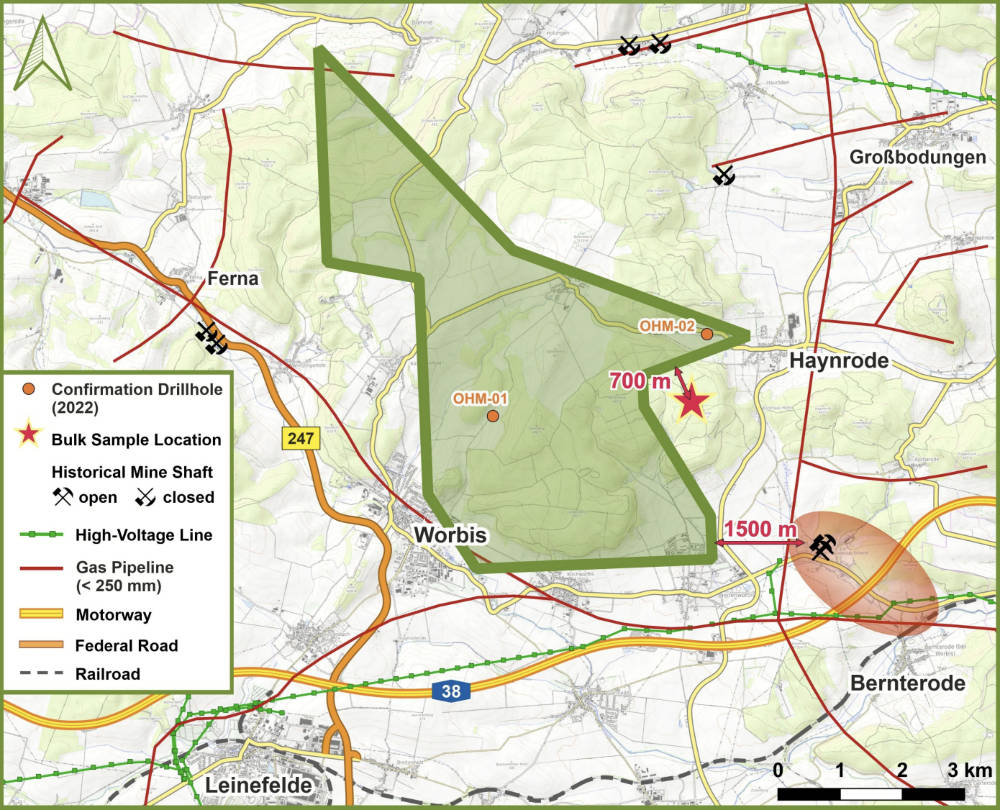New access deal could cut capex, accelerate development of South Harz’s Ohmgebirge potash flagship

The MoU for the use of existing infrastructure could reduce both capital costs and development time for South Harz Potash’s Ohmgebirge potash deposit. Pic: StefaNikolic via Getty Images.
- South Harz Potash has signed a non-binding deal that could accelerate access to its Ohmgebirge potash deposit
- MoU with Deusa could allow for long-term use of existing Bernterode shaft and associated infrastructure
- Optimised PFS to include this brownfield development pathway, which could reduce capital costs, development time
- Approval of key Spatial Planning Application expected within six months of application
South Harz has signed a non-binding memorandum of understanding that delivers a brownfield development pathway that could accelerate access to its Ohmgebirge potash deposit in Germany.
Ohmgebirge has a resource of 325Mt grading 13.14% K2O that covers essentially the entirety of the granted Ohmgebirge mining licence and has very little variation in mineralogy or grade.
Of this, 290Mt at 13.47% K2O is contained within sylvinite – an important source of potash – while 89% of the Ohmgebirge sylvinite seam is in the higher confidence Indicated category that has enough geological certainty for mine planning.
The deposit itself is part of South Harz Potash’s (ASX:SHP) wider project portfolio in Germany, which hosts a globally large-scale potash resource estimate of 5.3 billion tonnes at 10.8% K2O of inferred resources and 290 million tonnes at 13.5% K2O, 89% in the indicated resource category.
This neatly places a source of premium fertiliser right in the heart of Europe amongst its likely customers.
Fertilisers like potash are crucial for agriculture as it improves water retention, yield, nutrient value, taste, colour, texture, and disease resistance of food crops.
A scoping study from August 2022 outlined a robust 21 year, 1Mtpa MOP operation at Ohmgebirge – the first of five projects within the company’s portfolio – that will deliver post-tax net present value and internal rate of return (IRR) of US$1.28bn and 26.6% respectively.
Generally, higher IRRs make investments more desirable, making it a good way for investors to assess the potential return on their investment.
Adding further interest, the South Harz portfolio has similar scale to BHP’s Jansen potash project in Saskatchewan, Canada, for which the global mining giant has just approved a US$4.9bn Stage 2 investment that will transform it into one of the world’s largest potash mines with production capacity of ~8.5Mtpa.
That BHP has committed to the Stage 2 investment, which takes the total committed capex up past the US$15bn mark, while construction of the US$5.7bn Stage 1 is still underway speaks volumes about how the major views the fertiliser market.
Option to use existing shaft, infrastructure
SHP has now reached a non-binding memorandum of understanding with its neighbour Deusa for the long-term use of the existing Bernterode shaft and associated infrastructure.
This offers the company a brownfield development pathway that offers substantial time, capital cost and footprint advantages over constructing a shaft from scratch as the Bernterode shafts are just 1,500m from the Ohmgebirge tenement boundary.
The MoU grants SHP binding exclusivity 31 March 2024 to advance discussions towards a definitive commercial agreement with Deusa on the long-term use of the shaft and infrastructure.
Other benefits include:
- The land being already designated for industrial use, which will streamline permitting;
- Access to power, water and gas – reducing utility capital;
- Proximity to surface infrastructure such as rail and roads;
- Improved access to the underground orebody and meeting ventilation requirements; and
- Potential underground access to additional orebodies on existing South Harz permits for enhanced project scalability.

Bernterode is the preferred brownfield site. Pic: Supplied (SHP).
“The execution of this partnership MoU with Deusa continues to demonstrate the strong capacity of the world-class Ohmgebirge project to leverage existing regional infrastructure and a genuine brownfield development pathway,” managing director Luis da Silva said.
“The Bernterode infrastructure is located close to the Ohmgebirge tenement boundary and proximal to some of the thickest sections of the Ohmgebirge deposit. Its utilisation in the development of Ohmgebirge offers substantial physical, cost and time benefits to South Harz and its shareholders.
“The signing of this MoU is a landmark milestone for both parties. We look forward to building on this collaboration with Deusa and its people in advancing towards definitive commercial arrangements and delivering superior environmental, social and financial outcomes for both parties.
“I also look forward to providing further updates as key Ohmgebirge milestones are progressively delivered in coming months, including submission of the Spatial Planning Application and completion of the PFS.”
Coming activity
The milestone Spatial Planning Application, which will incorporate use of Bernterode infrastructure as the base case development pathway, is on track for submission in November and is expected to be approved within six months of that.
SHP has also shifted the delivery of the Ohmgebirge pre-feasibility study to early Q2 2024 to allow for the inclusion of the optimised Bernterode brownfield development pathway.
This is based on widening the existing Bernterode #2 shaft followed by installation of a Pocketlift conveyor and personnel/material cage.
Notably, optimisation of the PFS is central to improving economics for the Ohmgebirge development.
Further business development opportunities that may give rise to increased technical and commercial synergies between the two businesses will also be explored.
This article was developed in collaboration with South Harz Potash, a Stockhead advertiser at the time of publishing.
This article does not constitute financial product advice. You should consider obtaining independent advice before making any financial decisions.
Related Topics
UNLOCK INSIGHTS
Discover the untold stories of emerging ASX stocks.
Daily news and expert analysis, it's free to subscribe.
By proceeding, you confirm you understand that we handle personal information in accordance with our Privacy Policy.








